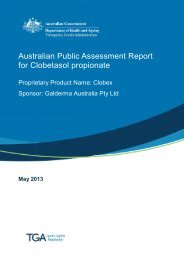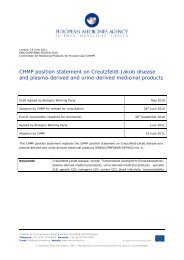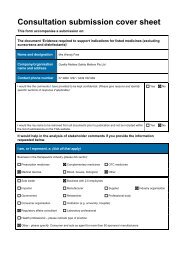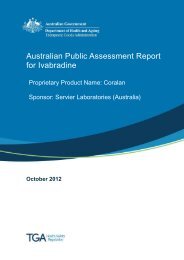Australian public assessment for Ibuprofen - Therapeutic Goods ...
Australian public assessment for Ibuprofen - Therapeutic Goods ...
Australian public assessment for Ibuprofen - Therapeutic Goods ...
Create successful ePaper yourself
Turn your PDF publications into a flip-book with our unique Google optimized e-Paper software.
AusPAR Caldolor <strong>Ibuprofen</strong> Phebra Pty Ltd PM-2010-02393-3-1<br />
Final 2 January 2013<br />
<strong>Therapeutic</strong> <strong>Goods</strong> Administration<br />
administration of the first dose of study medication, compared to the corresponding<br />
percentage in the placebo group.<br />
There are no regulatory guidelines relating to efficacy outcomes in studies of antipyretic<br />
medications. Published clinical studies have investigated a range of outcomes such as:<br />
• the percentage of patients whose temperature decreased below a set threshold over a<br />
predefined time period;<br />
• the percentage of patients whose temperature decreased by a set amount over a<br />
predefined time period;<br />
• the mean, maximum or minimum temperature over a predefined time period;<br />
• the rate of temperature change during a predefined time period;<br />
• cumulative measures of effect on body temperature such as the area under the<br />
temperature or change-in-temperature versus time curve over a predefined time<br />
period or the weighted sum of temperature measurements at different time points.<br />
Indirect efficacy measures such as the time to first use of rescue treatment have also been<br />
studied. Depending on the focus of the trial, the time period over which efficacy is assessed<br />
may be a single dose interval or may span several doses. For example, the PI <strong>for</strong> IV<br />
paracetamol (Perfalgan) states that in the pivotal antipyretic study supporting the<br />
registration of that product, the primary efficacy outcome was the mean change in body<br />
temperature at several time points from 0.5 to 6 h after a single dose, compared to<br />
placebo. However, that study also had a range of secondary efficacy outcomes<br />
encompassing most of the types described above.<br />
The thresholds <strong>for</strong> declaring a patient to be febrile and <strong>for</strong> subsequently declaring fever to<br />
have responded to treatment have also varied across studies. The temperature <strong>for</strong><br />
declaring a therapeutic response is often lower than the temperature required <strong>for</strong> the<br />
initial diagnosis of fever but it is not uncommon <strong>for</strong> the values to be the same in any one<br />
trial, as was the case in CPI-CL-004. Harrison’s Principles of Internal Medicine defines a<br />
fever as an oral temperature >37.2°C (>98.9°F) in the morning or >37.7°C (>99.9°F) in the<br />
afternoon, these being the upper 99th percentiles <strong>for</strong> normal body temperature at the<br />
respective times of day 11. The same text notes that rectal temperature (core temperature)<br />
is generally about 0.4°C higher than oral temperature, and that <strong>for</strong> most fevers, body<br />
temperature increases by 1°-2°C. Given these factors, the core temperature of 101°F<br />
(about 38.3°C) that was used <strong>for</strong> diagnosing fever in CPI-CL-004 was not particularly<br />
stringent. For comparison, the PI <strong>for</strong> Perfalgan states that in the pivotal antipyretic study,<br />
which was conducted in children, the minimum temperature <strong>for</strong> diagnosing fever was<br />
38.5°C.<br />
Similarly, the use of the same temperature <strong>for</strong> diagnosing a fever and declaring a<br />
treatment response meant that a response would have been relatively easy to obtain,<br />
particularly when one realises that patients were also receiving treatment (such as<br />
antibiotics, antimalarials) <strong>for</strong> the underlying cause of the fever. This was reflected in a<br />
substantial placebo response, particularly over the full 24 h treatment period. For<br />
comparison, in the pivotal study <strong>for</strong> Perfalgan the minimum temperature <strong>for</strong> diagnosing<br />
fever was 38.5°C but the temperature <strong>for</strong> declaring a treatment response (one of the<br />
secondary endpoints) was 38.0°C. This shortcoming of CPI-CL-004 was to some extent<br />
addressed in the additional analyses requested by the FDA, which examined the time to<br />
reach a temperature
















